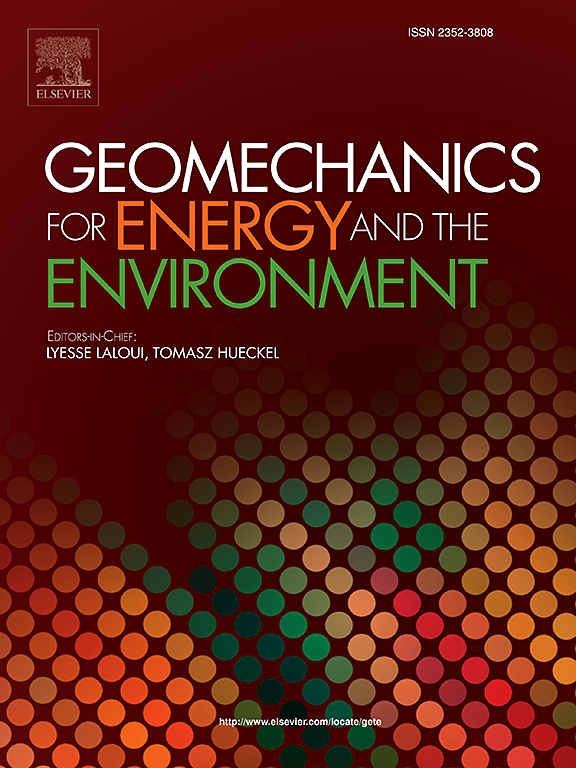The free-energy density function and its complementary forms for porous media saturated by two non-miscible fluids under non isothermal conditions
IF 3.3
2区 工程技术
Q3 ENERGY & FUELS
引用次数: 0
Abstract
This paper presents a general method for defining the macroscopic free-energy density function and its complementary forms for a porous medium saturated by two non-miscible fluids, in the case of compressible fluid and solid constituents, non-isothermal conditions and negligible interfacial surface energy.
The major advantage of the proposed approach is that no limitation or simplification is posed on the choice of the free energies of the fluid constituents. As a result, a fully non-linear equation of state for the pore fluids can be incorporated within the proposed framework.
The method is presented under the assumption that interfacial surface energy terms are negligible, thus recovering a Bishop parameter coinciding with the degree of saturation, which is expected to be applicable mostly to non-plastic soils. Moreover, small strains of the solid skeleton are assumed, but the method can be easily extended to a large strain formulation as discussed below. The paper analyzes also some particular cases concerning the incompressibility of all constituents, the geometric linearization and the incompressibility only of the solid constituent.
The knowledge of the free energy density function is the starting point for the evaluation of the dissipation function, of energy and entropy balance and, in general, for the formulation of thermodynamically consistent constitutive models.
非等温条件下两种非混相流体饱和多孔介质的自由能密度函数及其互补形式
本文提出了一种定义两种非混溶流体饱和多孔介质的宏观自由能密度函数及其互补形式的一般方法,该多孔介质具有可压缩的流体和固体成分、非等温条件和可忽略的界面表面能。所提出的方法的主要优点是对流体组分的自由能的选择没有限制或简化。因此,孔隙流体的完全非线性状态方程可以纳入所提出的框架内。该方法是在假设界面表面能项可以忽略不计的情况下提出的,从而恢复了与饱和度一致的Bishop参数χ,预计该参数主要适用于非塑性土壤。此外,假设实体骨架的小应变,但该方法可以很容易地扩展到下面讨论的大应变公式。文中还分析了所有成分不可压缩、几何线性化和仅固体成分不可压缩的一些特殊情况。了解自由能量密度函数是评估耗散函数、能量和熵平衡的起点,一般来说,也是制定热力学一致的本构模型的起点。
本文章由计算机程序翻译,如有差异,请以英文原文为准。
求助全文
约1分钟内获得全文
求助全文
来源期刊

Geomechanics for Energy and the Environment
Earth and Planetary Sciences-Geotechnical Engineering and Engineering Geology
CiteScore
5.90
自引率
11.80%
发文量
87
期刊介绍:
The aim of the Journal is to publish research results of the highest quality and of lasting importance on the subject of geomechanics, with the focus on applications to geological energy production and storage, and the interaction of soils and rocks with the natural and engineered environment. Special attention is given to concepts and developments of new energy geotechnologies that comprise intrinsic mechanisms protecting the environment against a potential engineering induced damage, hence warranting sustainable usage of energy resources.
The scope of the journal is broad, including fundamental concepts in geomechanics and mechanics of porous media, the experiments and analysis of novel phenomena and applications. Of special interest are issues resulting from coupling of particular physics, chemistry and biology of external forcings, as well as of pore fluid/gas and minerals to the solid mechanics of the medium skeleton and pore fluid mechanics. The multi-scale and inter-scale interactions between the phenomena and the behavior representations are also of particular interest. Contributions to general theoretical approach to these issues, but of potential reference to geomechanics in its context of energy and the environment are also most welcome.
 求助内容:
求助内容: 应助结果提醒方式:
应助结果提醒方式:


